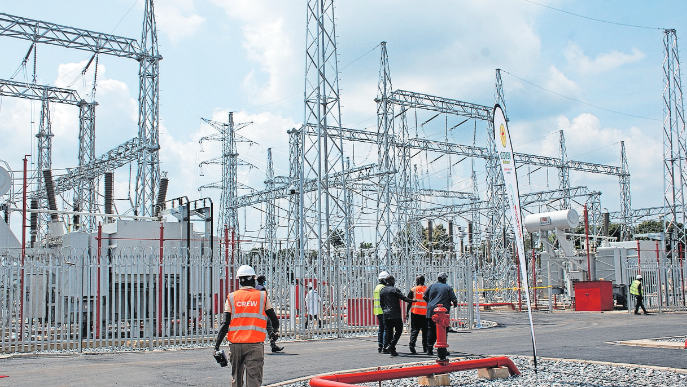Stable power supply paves the way for industrial parks in West Nile

Technicians at the Nebbi power substation. The stable power could is expected to spur development in West Nile sub-region. PHOTO | FELIX WAROM OKELLO
What you need to know:
- The sub-region is endowed with raw materials ranging from agricultural produce, and minerals to fish products that could be raw materials for factories once established.
The West Nile Sub-region, located about 450 kilometres from Kampala, is the heart of business for neighbouring South Sudan, Democratic Republic of Congo (DR Congo) and Central African Republic (CAR).
As a result, more than 500 trucks loaded with goods, pass through Goli, Padea and Vurra border posts from Uganda destined for DR Congo.
The situation is similar at Oraba, Afoji and Elegu border posts where hundreds of trucks cross to South Sudan and CAR daily.
The trucks are loaded with manufactured goods, agricultural and forest products, beverages and petroleum, among others.
The sub-region is endowed with raw materials ranging from agricultural produce and minerals to fish products that could be raw materials for factories once established.
River Nile would be an added advantage for fish processing factories that could be set up in Pakwach, Rhino camp, Panyimur, or Obongi District.
Area leaders now say the availability of stable power of about 90 megawatts from the national grid will enable industrialisation of the sub-region.
The State Minister for Investment, Ms Evelyne Anite, told Daily Monitor at the weekend that with the adequate power, government will kick-start the establishment of industrial parks in the sub-region.
“We now need value addition on all products. We all expect construction of better roads that can facilitate movement of raw materials,” she said.
The minister said the strategic location of West Nile should be utilised to develop the sub-region. “Lack of electricity had made it difficult to attract investors. Now that it is there, I believe we can attract foreign- based investors and West Nile people in diaspora can utilise the land and resources here. The time is now to invest in West Nile,” Ms Anite explained.
The value addition factory at Nsambia Cell in Arua Central division in Arua City is now engaging in full scale processing, just like the Enzeva Chicken processing factory.
The tobacco factory at Ajia is also crying no more for electricity .
Equally, the mango juice factory in Yumbe, once it starts full scale production, would be an economic gem for the district and sub-region as it offers employment for about 500 youth.
The Oyoma wine factory in Parombo that has been struggling with power, has potential of increased production. The factory that employs more than 500 skilled and semi-skilled people in Nebbi, Parombo Cotton Ginnery, Ayuda (Okoro Coffee) Union processing factory and Kyagulanyi coffee factory in Zombo District have now increased production.
At the end of last year, the management of 7 Hills Adrikos Gin factory announced the return of the factory in Arua due to the stable power. The Savon factory that is producing soap in Koboko also offers valuable opportunities.
Currently, fish from South Sudan that has found an abundant market in Arua and DR Congo offers a great potential for a factory. Every week, about 20 trucks of fish from South Sudan are offloaded in Arua City market.
The MP for Ayivu East Division, Mr Geoffrey Feta, said sufficient and stable electricity will enable factories to flourish. “The factories will accommodate manual, skilled and semi-skilled labourers,” he said.
He said the current upgrade of Arua airfield to an international airport will connect Uganda to the rest of the world.
“This region is naturally gifted with both flat and highlands with undulating mountainous sceneries that can attract establishment of factories and promote tourism,” he said.
The former MP for Ayivu County, Mr Bernard Atiku, said there is no better place for establishing factories for manufacturing various products destined for eastern DRC, Central African Republic, South Sudan and the Sudan than West Nile.
“The region should, therefore, prepare for an industrial boom that will create enormous employment opportunities. This will translate into increased household income, poverty reduction, improved standard of living and increased life expectancy,” he said.
While commissioning the 132kV power line that connected the sub-region to the national grid on August 3 in Nebbi, President Museveni said it must be used productively to spur development.
He said the government took long to connect the sub-region to the national grid because of low demand that was estimated to be a paltry 2.5 megawatts.
“We had to build this 132 Kilovolt power line that would be able to supply power to the West Nile. And that time, the demand was low, so we could not connect. Now that there is demand, we need to utilise the 90 megawatts through attracting investors who will establish factories,” he said.
The Energy Minister, Ms Ruth Nankabirwa, estimates that within one year, the demand for electricity in the sub-region increase from 3.5 megawatts to 10 megawatts due to the new connections and business prospects already in place.



